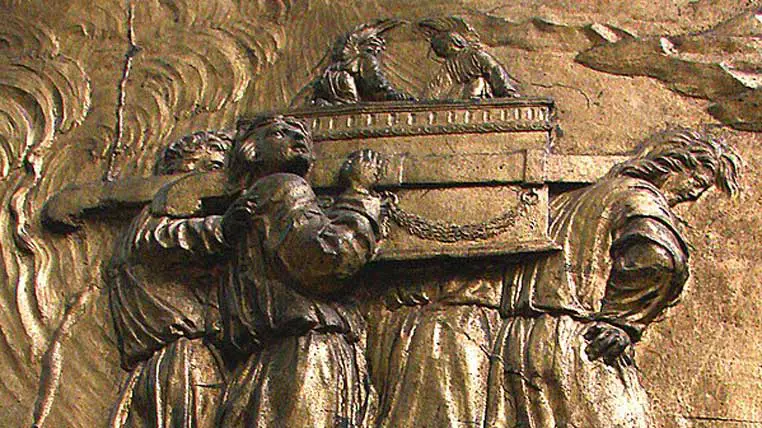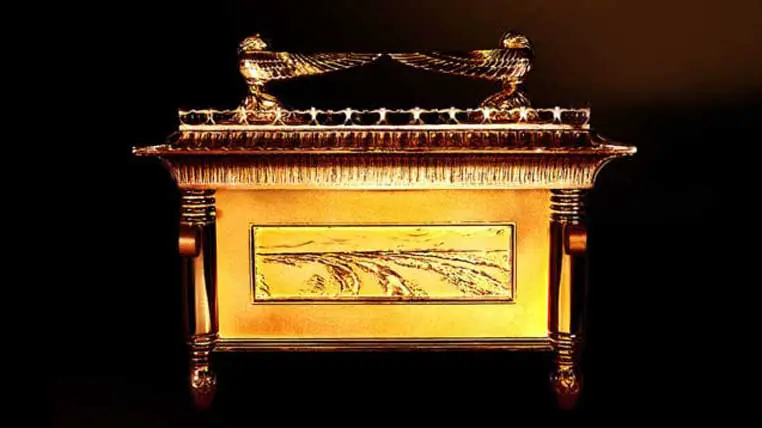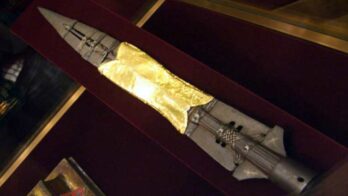The relic was described as a gold-covered wooden chest containing the tablets of the Ten Commandments, Aaron’s rod, and a jar of manna.
The Ark of the Covenant was considered the visible sign of God’s presence among the Israelites and was carried by them during their travels in the wilderness.
The final fate of the Ark of the Covenant is unknown, and it has been the subject of much speculation and mystery for centuries.
An Object of Imense Power
According to the Hebrew Bible, the Israelites built the Ark while wandering through the Sinai Desert after fleeing Egypt.
However, the exact time of the Israelites’ Exodus from Egypt is debated among scholars, and moreover, little historical evidence supports the claim that the Exodus actually happened.
According to the Tanakh, the Ark of the Covenant was considered a divine instrument with fearsome powers.
In one story, the Jordan River stopped flowing and remained still as priests carrying the Ark crossed the river.
Tales also describe how the Israelites took the Ark into battle, where the artifact’s powers proved instrumental in defeating their enemies.
While initially, it was said that the Ark of the Covenant only contained the tablets with the Ten Commandments, many other relics have been added to the list of mysterious objects “locked” inside the magical relic over time.
These sacred relics include Aaron’s rod, a miraculous staff with buds that grew leaves as a sign of God’s trust in Aaron, Moses’ brother.
According to legends, the Ark of the Covenant also contained a piece of manna, a mysterious food source that provided an inexhaustible food supply to the Israelites during their time in the desert.
Additionally, the Ark possessed a supernatural power that overwhelmed those who looked upon it, and it was a way for God to make His will known.
The Ark of the Covenant disappeared when the Babylonians conquered Jerusalem in 587 BC. Its whereabouts have remained a mystery since then, with numerous speculations about where it might be today.
The Building of the Ark of the Covenant
The Ark of God was built during the time of Moses and the Israelites’ journey through the Sinai desert.
The Bible describes the building of the Ark of God in great detail, outlining the various components and their specific measurements.
In fact, the entire design and the materials were carefully chosen to represent the Israelites’ reverence for God and their commitment to honoring His presence among them.
According to the Book of Exodus, God gave Moses specific instructions on how to build the Ark – it had to be constructed out of acacia wood and gilded entirely with gold, both inside and out.
The Ark’s dimensions were also precise, as God commanded: 2.5 cubits (approximately 51 inches or 131 centimeters) long, 1.5 cubits (about 31 inches or 79 centimeters) wide, and another 1.5 cubits high.
The Ark’s lid, known as the kapporet or “the mercy seat,” was also made of pure gold, and two golden cherubim were placed on top of the lid facing each other.
The cherubim represented the presence of God, and their outstretched wings formed a seat for the kapporet.
The Ark of the Covenant also had a crown or molding of gold around its top and four rings of gold on its feet, through which poles were inserted for carrying it.
These poles were made of acacia wood and were also covered in gold.
The construction of such a vessel was no small feat, as it required skilled craftsmanship and attention to detail.
According to the Hebrew Bible, a man named Bezalel was chosen by God to construct the Ark of the Covenant around 1462 BC.
The Tanakh also speaks of a second skilled craftsperson, Oholiab, who was chosen by God to be Bezalel’s assistant.
The two craftsmen and other carefully selected artisans were to construct the Ark of the Covenant precisely according to their instructions.
The Israelites’ dedication to the project was also evident, as they contributed generously to the construction of the Ark and other elements of the tabernacle.
The building of the artifact took approximately six months, from the time the Israelites began collecting the necessary materials to the completion of the construction.
After the Ark was finished, Israelites received instructions to cover it with a silk veil.
Are There Multiple Arks of the Covenant?
The Book of Deuteronomy mentions a less ornate Ark of the Covenant, quite different from the one in Exodus.
When Moses discovered that the Israelites were worshipping a golden calf, he shattered the tablets of the Ten Commandments.
As a result, God instructed Moses to carve new tablets and place them in a plain wooden chest.
Multiple such unadorned wooden chests could have been used simultaneously or at different moments.
Tudor Parfitt, a professor of religion at the International University of Florida, analyzed biblical texts in his book The Lost Ark of the Covenant: Solving the 2500-Year-Old Mystery of the Fabled Biblical Ark (HarperCollins Publishers, 2008).
He concluded that before the majority of Israelite religious ceremonies focused exclusively on the capital, Jerusalem, there were likely multiple sacred arks of varying types at all places of worship for God.
These early arks would have been simple wooden receptacles.
After the religious processions of the Israelites became centralized in Jerusalem, it is possible that the story was retold to describe an elaborate gold ark.

A Weapon of God?
The Ark of the Covenant was believed to possess tremendous powers, protecting the Israelites during their journey to the Promised Land.
Its power manifested several times during this long journey, putting enemies to flight.
For instance, the priests carrying the Ark of the Testimony entered the Jordan River, and the water stopped flowing, allowing the Israelites to cross safely.
During the Battle of Jericho, the Ark was carried in procession around the city walls for seven days, after which the walls fell, and the Israelites emerged victorious.
However, the Ark’s powers did not work every time.
For example, after losing several battles with the Philistines, the Israelites brought the Ark of the Covenant to the battlefield. They hoped the holy relic would inspire their army and terrorize the enemy ranks.
But the Philistines won the battle and captured the artifact, seeing it as a victory over the Israelites and their God.
Despite being considered a valuable trophy, further disasters befell the Philistines, including a plague that spread quickly and rat infestations wherever the object was stored.
After enduring a series of misfortunes, the Philistines constructed a cart to transport the Ark and symbols of their afflictions. Two oxen were yoked to the cart, then driven out of their territory.
The cart eventually arrived in Israelite territory and was received by the people of Bethsames. However, many lost their lives because, according to legends, they did not respect the Ark of the Covenant properly, fearing its power.
Therefore, the artifact was transferred to the nearby settlement of Cariathiarum, where it was given the appropriate reverence.
After the Israelites settled in the Promised Land, the artifact was eventually placed inside the Temple of Solomon in Jerusalem, where it remained until it was stolen or destroyed during the Babylonian conquest of Jerusalem.
The Ark of God's Journey Through History
The historical journey of the Ark of God remains shrouded in mystery and ambiguity, with unproven references and unclear evidence.
For example, archaeological excavations have revealed evidence of significant cultic activity at Kiriath Jearim, also known as Abu Ghosh, during the 8th and 7th centuries BC.
However, this was long after the Ark was purportedly relocated from Abu Ghosh to Jerusalem, which had become a significant religious center during that time.
This raises the question of what the inhabitants of Abu Ghosh were worshipping during this period.
According to Thomas Römer, a theologian with a Ph.D. from the University of Lausanne, the Ark may not have been moved to Jerusalem until the reign of King Josiah.
This could explain why the Ark of the Covenant held significant importance in Judaism before King Solomon, but its significance declined afterward.
Some scholars also suggest that the story of the Ark was initially written in an independent text called “The Narrative of the Ark” around the 8th century and was later integrated into the biblical narrative just before the Babylonian exile.
Römer further speculates that the artifact could have been encrusted with sacred stones “of the type found in the coffers of pre-Islamic Bedouins.”
He proposes two explanations for the cherubims on top of the lid:
- Representations of Yahweh, the name of God in some versions of the Tanakh, according to which Yahweh is one of the sons of El, but this was “edited” out by an amendment to the Hebrew Bible text.
- A pair of statues depicting Yahweh and the Canaanite goddess Asherah (goddess mother mentioned in the Ras Shanvra texts as the goddess of the sea and wife of the god El).
In contrast, Scott Noegel, a renowned author and professor of biblical studies at the University of Washington, has argued that the parallels between the Ark and the religious practices of the Bedouins “remain unconvincing.”
Noegel believes most Bedouin objects lack the Ark’s distinctive structure, purpose, and transportation.
Specifically, unlike the Ark of the Covenant, the Bedouin coffers “contained no box, no lid, and no pillars,” did not serve as a throne or seat for any god, were not covered with gold, had no figures of cherubim on top, there were no restrictions on who could touch them, and they were transported on horses or camels.
The Ark of God Vanishes
The Ark of the Covenant’s whereabouts became a mystery when King Nabucodonosor II (630-562 BCE) attacked and occupied Jerusalem.
The artifact may have been destroyed along with the city, or it might have been taken as war booty to Babylon, as suggested in Kings 4:25.
Some theologians believe that the Israelites, remaining loyal to their God, were warned about the impending fall of Jerusalem and moved the Ark of the Covenant to a safe location.
According to this theory, Jeremiah took it to a cave on Mount Sinai, the Egyptian massif where Moses first spoke with God.
In the Talmud, an ancient and influential source of Jewish history, it is suggested that the artifact was kept in a secret place in Solomon’s Temple and survived the destruction and looting of Jerusalem.
The Temple of Solomon was reconstructed on its original foundations after the Babylonian captivity.
Although the Ark of the Covenant should have been there, it was not listed among the valuables taken from the new temple by a successor of Alexander the Great around 150 BC.
The interest in the Ark of the Covenant has persisted throughout the centuries. In the Middle Ages, rumors circulated that the Knights Templar possessed it.
The popularity of the film Raiders of the Lost Ark has renewed interest in the relic.
The film portrays the Ark as a powerful object capable of bringing destruction to sinners and the vain.
The relic is discovered by American archaeologist Indiana Jones and pursued by Nazi forces in a race against the clock. Eventually, the Ark ends up in an unmarked box in a crowded US government storage facility, waiting to be archived.

Where is the Ark of the Covenant?
The Jewish and Christian traditions present the Ark of the Covenant as a physical manifestation of God’s supreme presence and power.
The ancient Israelites carried the Ark of the Covenant into battle, bringing entire cities to their knees.
The Ark was so sacred that touching it meant instant death. Once it was placed in the holiest chamber of the Jerusalem Temple, only the High Priest was granted permission to be in its presence, and only once a year.
Then the armies of Babylon raided Jerusalem in the 6th century BCE, and the Ark vanished. For millennia, the fate of one of Christianity’s most important artifacts has intrigued archaeologists, theologians, and scholars.
The Legendary Queen of Sheba
One of the most widely known theories about the whereabouts of the Ark of the Covenant today is linked to the Kebra Nagast, Ethiopia’s national epic written at the beginning of the 14th century.
According to these ancient texts, in the 10th century BCE, the Queen of Sheba spent time with King Solomon in Jerusalem.
After returning to Ethiopia, the Queen of Sheba gave birth to a son named Menelik, who later returned to Jerusalem when he was of age.
The young man, however, could not adapt to life at the court of King Solomon, so he decided to return home to Ethiopia, where he was to rule alongside his mother.
Solomon accepted the young prince’s decision but insisted that he be accompanied by a company of Jewish descendants on his journey back.
The soldiers, however, frustrated at being forced to leave Jerusalem, decided to take a souvenir with them: the Ark of the Covenant.
The news that the artifact had been stolen arrived too late for King Solomon’s ears, but by then, the Ark was already in Aksum, Ethiopia.
Using the power of the Ark, Menelik won many important victories against his enemies and laid the foundations for what would become the Ethiopian Empire.
The Kebra Nagast and the legend of the Ark of the Covenant are prominent components of Ethiopia’s national history.
Despite the belief of numerous scholars that the text is apocryphal, the Solomonic Dynasty of Ethiopian monarchs, who reigned until 1974, claimed to be directly descended from Solomon and Menelik.
Emperor Haile Selassie, I enshrined this biblical connection in his constitutions of 1931 and 1955.
The Ethiopian Tewahedo Orthodox Church, the country’s largest religious denomination, also acknowledges the Kebra Nagast as legitimate Christian history.
Church leaders maintain that the Ark of the Covenant is located in the Church of St. Mary of Zion, in Aksum, where it is vigilantly safeguarded by a monk prohibited from leaving the sacred grounds for the duration of his life.
Despite the artifact being strictly off-limits, the Ark of the Covenant’s impact is perceptible throughout the Ethiopian Orthodox community.
Every Ethiopian Orthodox church owns a “tabot,” a sacred replica of the Ark, which is kept in Qeddest Qeddusan, or the Holy of Holies. It is exclusively removed during festivals and times of need.
According to other accounts, the object was transported to Abyssinia (Ethiopia) during a Jewish migration before the Babylonian captivity. It allegedly resided on an island in the middle of Lake Tana.
As Christianity disseminated throughout the Roman world around 300 CE, Abyssinia became predominantly Christian.
As a result, in the 16th century, violent conflicts erupted between the Christian kingdom of Abyssinia and invading Muslims, leading to considerable destruction, including the razing of monasteries on the island of Tana Kirkos, where the Ark was purportedly held.
After the Muslim armies retreated, a cathedral was constructed here, within which, according to legend, the Ark was securely stored.
In December 2000, Erling Haagensen and Henry Lincoln hypothesized that the Holy Grail and the Ark of the Covenant were concealed on the island of Bornholm, in the Baltic Sea, circa 1170.
Despite various theories and claims of its location, concrete evidence has yet to be found regarding the Ark’s whereabouts.
The mystery of the Ark’s disappearance has given rise to countless speculations, myths, and legends, making it one of the most enduring mysteries of biblical history.
A Shocking Theory: The Ark Was A Radio Transmitter
In 1969, the Swiss author Erich von Daniken proposed a controversial hypothesis that the Ark of the Covenant was a radio transmission station powered by several hundred volts.
According to von Daniken, the relic was, in fact, a technical invention constructed according to precise instructions given by God to Moses, including specific dimensions, a particular alloy of metals, and the exact placement of different levers and rods, leaving little to chance.
God informed Moses that He would speak to him directly through the Ark and warned him that no one was to approach it. Then, God provided precise instructions regarding the garments and footwear to be worn by those who transported it.

Despite all precautions, an accident still occurred when King David of Israel (c. 1010–970 BC) ordered the transport of the Ark.
Entrusting Uza to accompany it, at one point, some oxen passed by and sniffed the Ark, nearly overturning it. Uza put his hand on the chest but fell to the ground and died as if struck by lightning.
Von Daniken’s theory proposed that the Ark of the Covenant was a device charged with electricity.
If reconstructed today, following Moses’ instructions precisely, it would result in a conductor of several hundred volts.
The capacitor would have two gold plates, one positive and one negative, with one golden cherub mounted on the cover as a magnet.
Basically, the device would be a powerful megaphone and perhaps even a transmission-reception system, allowing anyone to maintain a permanent connection with “God.”
In fact, since the Bible does provide detailed instructions on constructing the Ark of the Covenant, von Daniken’s theory was tested and proven somehow correct.
Some researchers reconstructed the Ark of the Covenant using the information provided by the ancient texts. The intricate device generated no electricity as some essential parts were missing.
The researchers concluded that the description provided by the Bible was incomplete, or maybe people back then did not have the mental capacity to comprehend all the intricate parts of such a complex device.
Moses Was Talking to God Through the Ark
According to ancient texts, the Ark of the Covenant was often surrounded by sparks, and Moses used this “emitter” whenever he needed help or advice.
The prophet heard the voice of the Lord, but His face could never be seen.
When Moses asked to see God’s face, the Lord responded:
You cannot see my face, for no one may see me and live.
Instead, God tells Moses to stand behind Him on the rock and that when His glory passes by, Moses can only see His back.
Interestingly, there are similar references in the Epic of Gilgamesh, a Sumerian legend that predates the Bible.
The fifth tablet reads:
No man can reach the mountain where the gods dwell, and he who looks at the gods face to face must die.
Have you ever wondered why the “gods” in ancient myths and legends did not show their faces or were afraid to reveal themselves?
Was it their desire to keep their anonymity or something else entirely? Perhaps the story of Moses from Exodus originates in the Epic of Gilgamesh, an ancient Babylonian tale.
It’s entirely possible that Moses, who was raised in the Pharaoh’s court, had access to libraries or could obtain information about ancient mysteries. This raises questions about the compilation date of the Old Testament.
King David of Israel, who lived much later, fought with giants with six fingers on their hands and feet (2nd Book of Kings, XXI, 18-22).
All these myths, legends, and stories from ancient times were likely collected in one place, then later spread, copied, and mixed in different countries.
Most historians believe that if the 3,000-year-old relic existed, it has either disintegrated or been destroyed.
However, this remains speculation. For many, the final fate of the Ark of the Covenant remains a fascinating and unsolvable mystery.
At Ancient Theory we only use trusted sources to document our articles. Such relevant sources include authentic documents, newspaper and magazine articles, established authors, or reputable websites.
- Ark of the Covenant. wikipedia.org. [Source]
- Owen Jarus and Jonathan Gordon - What is the Ark of the Covenant?
- Bernstein Henrietta - The Ark of the Covenant, the Holy Grail. DeVorss Publications, 1998.
- Hancock Graham - The Sign and the Seal: The Quest for the Lost Ark of the Covenant. Crown, New York, 1992.
- Richard A. Lovett and Scot Hoffman - Why the Ark of the Covenant is one of history's enduring mysteries.
- Lee Brown - Christians in Ethiopia never saw the ‘Ark of the Covenant’ they died for.
- Tudor Parfitt - The Lost Ark of the Covenant: Solving the 2,500-year-old Mystery of the Fabled Biblical Ark. Harper Collins, 2008.
- The fate of the Lost Ark Revealed? history.com. [Source]
- Ancient Jewish History: The Ark of the Covenant. Jewish Virtual Library. [Source]






